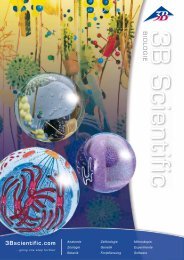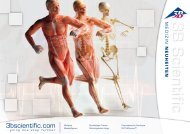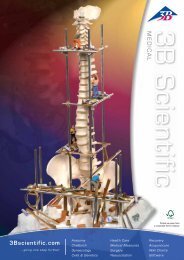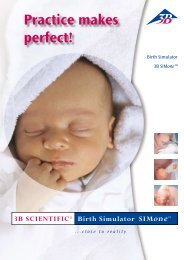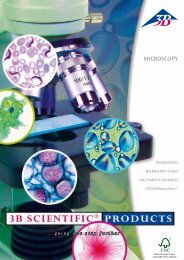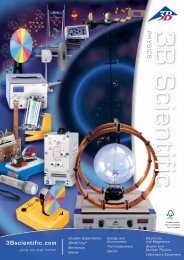3B Scientific - Biology Catalog
3Bscientific.com
3Bscientific.com
You also want an ePaper? Increase the reach of your titles
YUMPU automatically turns print PDFs into web optimized ePapers that Google loves.
Microscopy Microscope Slides – Series<br />
Pig Embryology (Sus scrofa)<br />
10 preparations with accompanying guide.<br />
For details, please go to www.3bscientific.com.<br />
9982-1003987<br />
Mitosis and Meiosis Set I<br />
6 selected Microscope Slides. With depictured accompanying<br />
brochure<br />
1(d). Mitosis, l.s. from Allium root tips showing plant mitosis<br />
stained with iron-hematoxyline 2(f). Mitotic stages in sec. of<br />
red bone marrow 3(e). Meiotic and mitotic stages in sec. of<br />
Salamandra testis 4(f). Lilium, anther t.s., microspore mother<br />
cells showing telophase of first and prophase of second division<br />
5(f). Giant chromosomes, smear from salivary gland of<br />
Chironomus 6(f). Ascaris megalocephala embryology. Sec. of<br />
uteri showing maturation stages.<br />
9982-1013468<br />
Mitosis and Meiosis Set II<br />
5 selected Microscope Slides. With depictured accompanying<br />
brochure<br />
1(d). Mitosis, l.s. from Vicia faba (bean). root tips showing all<br />
mitotic stages. Iron hematoxyline 2(f). Lilium, anther t.s.,<br />
micro spore mother cells showing telophase of first and prophase<br />
of second division 3(h). Mitotic stages in sec. of whitefish<br />
blastula showing spindles 4(f). Spermatogenesis with<br />
meiotic and mitotic stages, sec. of testis of grasshopper 5(g).<br />
Paramaecium, in fission, nuclei stained.<br />
9982-1013474<br />
The Ascaris megalocephala Embryology<br />
10 Microscope Slides. With depictured accompanying<br />
brochure<br />
1(d). Cell division in l.s. of Allium root tips, showing all mitotic<br />
stages 2(e). Ascaris, primary germ cells in the growing zone<br />
of oviduct 3(f). Ascaris, entrance of sperm in the oocytes<br />
4(f). Ascaris, first and second maturation divisions in oocytes<br />
I, 5(f). Ascaris, dito. in oocytes II 6(f). Ascaris, mature oocytes<br />
with male and female pronuclei 7(f). Ascaris, early cleavage<br />
stages 8(f). Ascaris, later cleavage stages 9(d). Ascaris, adult<br />
female, t.s. in region of gonads 10(d). Ascaris, adult male<br />
roundworm, t.s. in region of gonads.<br />
9982-1013479<br />
Development of the Microspore Mother<br />
Cells of Lilium candidum<br />
12 Microscope Slides. With depictured accompanying<br />
brochure<br />
1(e). Leptotene, the chromosomes appear as fine threads<br />
2(e). Zygotene, the homologous chromosomes associate in<br />
pairs 3(e). Pachytene, complete pairing of the chromosomes<br />
4(e). Diplotene, shortening of the chromosomes by contraction.<br />
Interchange of chromatin (crossing over) 5(e). Diakinesis,<br />
further contraction of the bivalents 6(f). Metaphase and<br />
anaphase of the first (heterotypic). division 7(f). Telophase of<br />
the first and prophase of the second division 8(f). Metaphase<br />
and anaphase of the second (homeotypic). division 9(f). Pollen<br />
tetrads after the second division, each bearing the haploid<br />
number of chromosomes 10(e). Uninucleate microspores<br />
11(e). Mature two-nucleate pollen grains at the time of shedding<br />
12(b). Mature pollen grains, w.m. to show structure of<br />
the cell walls.<br />
9982-1013484<br />
ECOLOGY AND ENVIRONMENT<br />
The Forest, Consequences of Pollution<br />
20 Microscope Slides<br />
1(c). Pine (Pinus), healthy leaves, t.s. 2(c). Pine (Pinus) leaves<br />
damaged by acid rain, t.s. 3(c). Fir (Abies), healthy leaves, t.s.<br />
4(c). Fir (Abies), stem tip damaged t.s. 5(c). Beech (Fagus),<br />
healthy leaves t.s. 6(c). Beech (Fagus), t.s. of leaves with destroyed<br />
epidermis and chloroplasts 7(d). Rhytisma acerinum,<br />
tar spot of maples, consequence of single-crop farming 8(d).<br />
Early leaf fall, caused by thawing salt 9(d). Healthy lichen,<br />
indi cator of clean air 10(d). Damaged lichen, caused by air<br />
pollution 11(c). Healthy wood of beech, t.s. 12(d). Wood destroyed<br />
by fungus 13(d). Polyporus, wood rot fungus, fruiting<br />
body t.s. 14(d). Root nodules of Alnus, with symbiotic bacteria<br />
15(d). Spruce beetle (Cryphalus picea), larva t.s. 16(c).<br />
Wood with normal annual rings, t.s. 17(c). Wood with anomalous<br />
narrow annual rings caused by drought, t.s. 18(d). Bark<br />
with larval galleries of spruce beetle, t.s. 19(d). Pineapple-like<br />
gall on spruce caused by lice, t.s. 20(d). Gall nut on oak<br />
caused by insects, t.s.<br />
9982-1004256<br />
Water Pollution, Problems and Results<br />
20 Microscope Slides<br />
1(d). Intestinal bacteria (Escherichia coli) from putrid water<br />
2(e). Putrefactive bacteria (Spirillum) from sludge poor in<br />
oxy gen 3(d). Putrefactive bacteria (Sphaerotilus) bacteria,<br />
forming long chains 4(d). Sludge bacteria (Methanobacterium)<br />
causing sewer gas 5(d). Sulphur bacteria (Thiocystis)<br />
6(c). Cyanobacteria (Microcystis), blue-green algae “blooming”<br />
in stagnant water 7(c). Anabaena, blue green algae, in<br />
eutrophic water 8(c). Spirogyra, filamentous green alga in<br />
nutrient-rich water 9(d). Spirulina, corkscrew-shaped algae<br />
occurring in bitter seas 10(c). Chlamydomonas, one-celled<br />
green alga in eutrophic water 11(c). Cladophora, green alga<br />
from moderately polluted water 12(c). Diatoms, mixed algae<br />
from scarcely polluted water 13(c). Euglena, green flagellates<br />
occurring in stagnant eutrophic water 14(d). Ciliates, different<br />
species from nutrient-rich water 15(d). Rotifers (Rotatoria),<br />
small animals from putrid water 16(d). Tubifex, fresh<br />
water oligo chaete, living in the sludge 17(d). Carchesium,<br />
stalked ciliate from moderately polluted water 18(d). Water<br />
mold (Saprolegnia), harmful to plants and animals 19(d).<br />
Skin of fish injured by chemicals, t.s. 20(d). Skin ulcer of an<br />
amphibian, t.s.<br />
9982-1004257<br />
Life in the Soil<br />
17 Microscope Slides<br />
1(d). Acidophile soil bacteria, solution of heavy metals 2(d).<br />
Ni trite bacteria, forming harmful nitrogenous substances<br />
3(d). Root of beech with ectotrophic mycorrhiza, t.s. 4(d).<br />
Root of birch with partly endotrophic mycorrhiza, t.s. 5(d).<br />
Root of lupin with symbiotic nitrogen fixing bacteria 6(d).<br />
Netted venation, portion of rotted deciduous leaf 7(c). Charlock<br />
(Sinapis), t.s. of stem. Green manure plant 8(d). Soil<br />
bacteria (Bacillus megaterium), smear 9(d). Hyphae of root<br />
fungi, t.s. 10(d). Lichen, indicator of clean air 11(c). Mushroom<br />
(Xero comus), mycelium 12(c). Root of willow (Salix),<br />
planting protecting against erosion 13(c). Earthworm<br />
(Lumbri cus) t.s., causing soil improvement 14(d). Springtails<br />
(Collembola), w.m. 15(d). Mite from forest soil, w.m. 16(c).<br />
Con stitu ents of humus soil 17(c). Constituents of peaty soil.<br />
9982-1004258<br />
94 <strong>3B</strong> <strong>Scientific</strong>® <strong>Biology</strong>




